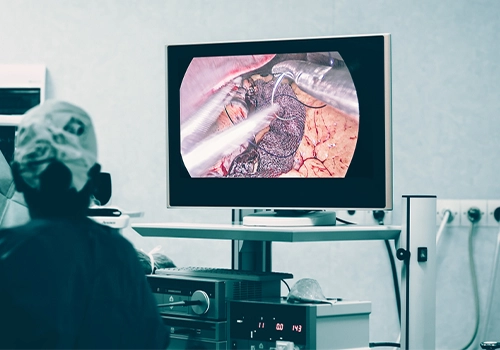Exploring the Advancements and Impact of Gastric Balloon Therapy in Weight Management
Today, more and more people are dealing with the problem of being overweight. In this regard, some new medical treatments have been proposed to help with this problem. One of the interventions that has become very popular is called gastric balloon.
It is a non-surgical and temporary weight loss method that helps people lose a significant amount of weight. In this regard, Dr. Maadico’s Cosmetic Department in Iran also offers Gastric Balloon, a minimally invasive solution designed to help achieve significant and sustainable weight loss.
In this essay, we will learn all about the Balloon weight loss procedure. We will explore how it works, how well it works, and how it can help people who want to lose weight safely and gently. We will talk about what it does to our digestive system, and the good and important things we need to think about when using Gastric balloons to help with weight management.
Candidate for Gastric balloon
Balloon weight loss procedure makes people feel full and eat less.
- This can help those who have failed at weight loss before.
- Balloon weight loss procedure help somewhat overweight people. It suits people with 28–40 kg/m2 BMIs. This weight-loss method differs from Gastric banding, sleeve gastrectomy, and bypass.
- Balloon weight loss procedures are recommended for 85–130-kilogram people.
- Sometimes this therapy prepares excessively overweight people for stomach-slimming surgery. Before surgery, lose weight to lower risks.
Who shouldn’t get a Balloon weight loss procedure?
- Physical and mental issues can make Gastric balloon use risky.
- Past surgeries, stomach or esophagus difficulties, stomach ulcers, and toxic chemicals must be considered.
- If you have bulimia or another serious mental illness, avoid Gastric balloons.
- This is not recommended for pregnant women.
- Long-term anticoagulant users cannot have stomach balloon treatments
- Individuals with Liver disease.
- Individuals with Substance use disorder.
What is a Gastric balloon?
Balloon weight loss procedure help patients reduce weight within their stomachs. It lowers food intake by filling the stomach. Tiny tubes inserted through the lips place balloons in the stomach—the balloon Inflates after installation. It helps people lose weight without surgery. Different weight-loss methods exist.

A simple idea powers Gastric balloons. It takes up a lot of stomach space when full of liquid or air. So, the person feels full faster and eats less. The Inflatable gastric balloon is merely part of obesity treatment. In Soft silicone Gastric balloons, the soft substance can hold liquid or air. A doctor inserts a balloon into the stomach during a gastroscopy and this balloon checks the stomach.
Gastric balloon implantation
- Hospital or clinic doctors execute the procedure.
- Before surgery, you must evaluate your esophagus and stomach before inserting the Gastric balloon.
- Using esophagogastroscopy, your throat and stomach are examined. Doctors do a test to detect changes that could make Gastric balloon insertion difficult.
- A gastroscopy involves a clinician delicately putting an endoscope into the mouth. The tube enters the stomach via the esophagus. A camera and light are on this tool.
- At this visit, the doctor will check your esophagus and stomach for abnormalities.
- After withdrawing the endoscope, the doctor carefully inserts the foldable Gastric balloon through a tube.
- After the Inflatable gastric balloon reaches the stomach, the doctor examines it endoscopically. Tubing fills the balloon with the solution. Usually, 400–700 cc of fluid goes into the balloon.
- The doctor will then remove the tube and gently find the balloon using an endoscope.
The surgery takes 20–30 minutes. Patients receive relaxing medicine throughout this time. We call this lightly sedated. This simple method doesn’t require an overnight stay. Patients should not drive or use machinery after anesthesia.
After the Inflatable gastric balloon is placed, some people may feel bloated or vomit. The surgery usually requires a one- to two-day hospital stay. Patients will receive critical fluids via IV. Gastric balloon implantation in Tehran is a viable option for weight loss, offering a cost-effective solution that can significantly improve patients’ lives.

Gastric balloon removal
Doctors will initially give a relaxing drug to make Gastric balloon removal easier. They’ll use an endoscope. Flexible, long camera tube. A doctor will gently insert the endoscope into the stomach through the mouth.
To prevent stomach acid and movement from damaging the Gastric balloon, Doctors remove it after six months. An extra gastroscopy is needed to remove the Gastric balloon. The doctor carefully punctures the balloon to release the liquid. Stomach balloons soften. Softening makes it easier to pull through the esophagus. It normally takes a few minutes.
Examine Gastric balloon performance
Gastric balloons reduce weight. We must evaluate numerous aspects to determine its efficacy.
- First, measure the Gastric balloon weight reduction.
- Balloon weight loss procedure efficiency varies substantially. 10–25 kg of weight loss is possible.
- Weight loss is obvious in the first three months.
- Healthy eating is essential for weight loss.
- Gastric balloons can cause weight gain. Too much sweet food or drink does this.
- Gastric balloons rarely work as well as surgery.
Gastric balloon side effects
- They may be visible in the first several days following feeding.
- Stomachache symptoms.
- The desire to vomit is nausea.
- Butterfly stomach pain is another indication.
- Even after eating a little, your stomach may feel full.
- Some may feel pressed, full, burp, and have heartburn.
These signs may irritate your stomach. After gut adjustment, these symptoms normally disappear. Three to seven days are common. Remove the Gastric balloon quickly if it causes problems.
Risks and issues
Possible risks include injury or danger. Like any medical procedure, Gastric balloon insertion involves precautions too.
- Stomach issues: Less than 3% of people have symptoms that persist for more than a week and don’t improve with medication. Another endoscopy will be needed to fix or remove the balloon in these patients.

- Hyperinflation: it refers to the spontaneous over-inflation of the gastric band, which can lead to complications. This can induce persistent stomachaches. May have to deflate the balloon sooner than intended. It is better for healthcare providers to monitor patients for potential complications, including hyperinflation.
- Deflation: If the balloon pops, it may migrate from your stomach to your intestines. This has a 1.5% chance. Each type of intragastric balloon has its unique tracking device. These devices are smart because they can notify you and your healthcare team of issues.
Balloons may enter our intestines. They usually pass through our intestines without issue. However, a balloon could get caught and clog our intestines causing an intestinal blockage.
- Pancreatitis: The pancreas becomes inflamed and painful. The bubble in your stomach may press on your pancreas behind it. In severe cases, acute pancreatitis can be painful and serious. If the balloon is to blame, remove it.
- Ulceration: balloons are made of soft silicone. They are smooth and round like balls, so they fit well in your tummy! To avoid stomach irritation, we must ensure the balloon doesn’t annoy it. The balloon’s pressure in the lower stomach may have caused stomach ulcers in some people.
When a balloon is inserted or removed from the esophagus, it might cause ulcers. If left untreated, an ulcer can be dangerous. It can damage your gastrointestinal lining, which protects your stomach. Excessive wear can cause perforation. It’s crucial to treat ulcers and let them recover.
Gastric balloon Burst
The nighttime balloon pops require emergency care treatment.
- A strange blue liquid comes out as the balloon pops.
- Our mucosal membrane absorbs this liquid. Like an absorbent sponge, it lets blue liquid into our bloodstream.
- Urine changes color. Patients using Gastric balloons should monitor their pee color. This may imply balloon issues.
The broken Gastric balloons should be removed quickly. Doctors check the stomach using a gastroscopy. This secures balloon removal and prevents intestine troubles. Call your doctor immediately if you fear a stomach balloon rupture.

Final step
Gastric balloons implantation is a novel method that blends aesthetics and health. Meticulous pre-procedural examinations and a variety of implantation procedures make gastric balloons more than just cosmetic interventions but a weight management option.
Your candidacy for the surgery must be determined before starting this transformational journey to weight loss. For tailored advice, talk with Dr. Maadico’s Cosmetic Department experts.
Dr. Maadicos’s specialists provide thorough assistance and knowledge to ensure a successful weight control journey, for each patient. Explore your options and start your healthier, happier life with a consultation now.
If you’re ready for a change, request a free consultation.
You may also be interested in knowing about:
Bariatric Surgery
Mini Gastric Bypass
Gastric Bypass Operation
Weight Loss by Gastric Banding
Weight Loss with Plication
FAQs
- How long does a Balloon weight loss procedure last?
A Gastric balloon is typically left in place for six months. After this period, it is removed to prevent potential complications. The removal process is relatively straightforward and involves the use of an endoscope.
- Can I drink alcohol with a Balloon weight loss procedure?
It’s advisable to limit alcohol consumption while the Gastric balloon is in place. Alcohol can irritate the stomach and may contribute to discomfort. Always consult with your healthcare provider regarding specific dietary guidelines during the treatment period.
- Can a Balloon weight loss procedure fail?
While Gastric balloons can be effective in weight loss, individual responses may vary. In some cases, patients may not achieve the desired weight loss, and the efficacy can depend on various factors, including lifestyle changes and adherence to dietary recommendations. Regular follow-ups with healthcare providers are essential to monitor progress
- How painful is a Balloon weight loss procedure?
The insertion of a Gastric balloon is a minimally invasive procedure typically performed with the patient under light sedation. Some individuals may experience mild discomfort, bloating, or nausea initially, but these symptoms often subside within a few days. The removal process is similarly managed with a relaxing drug and is generally well-tolerated.
- Is the Balloon weight loss procedure procedure available in Iran?
Yes, the gastric balloon procedure is available in Iran and is often considered a cost-effective option. Iran boasts excellent healthcare facilities with skilled doctors experienced in weight management interventions. Patients may find the procedure more affordable in Dr. Maadico’s Cosmetic Department.


